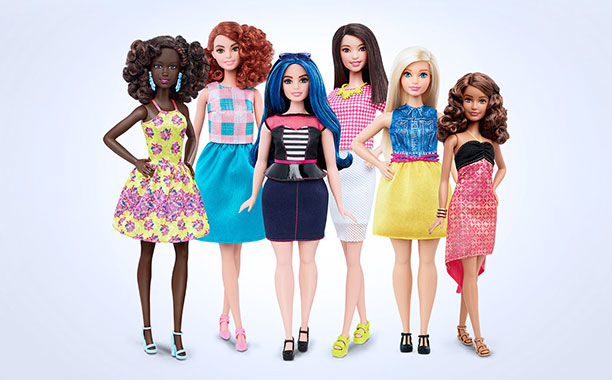Mattel Revamps Barbie, Releases Dolls with Three New Body Types as Part of Massive “Project Dawn” Overhaul
Project Dawn, coming next summer from Michael Bay!

Beginning today, Mattel will be selling Barbies with three new, diverse body types on Barbie.com alongside the “original,” cartoonishly-proportioned Barbie. The “petite, tall and curvy” dolls were designed as part of the dramatically entitled “Project Dawn,” led by Evelyn Mazzocco, head of the Barbie brand.
Project Dawn’s inclusivity was prompted by customers who have long been concerned about the impact the doll’s unrealistic proportions have been shown to have on young fans. The brand also needed to address the recent drop in global Barbie sales, due, at least in part, to the popularity of Hasbro’s Elsa toys.
In a feature on Project Dawn, TIME‘s Eliana Dockterman explains that although Elsa might be nearly as blonde and skinny as the “classic” Barbie, her feminist backstory from the film and her recognizability as a character make her partially exempt from the criticism that’s been leveled at Barbie since she was first created. TIME writes,
As much as Mattel has tried to market her as a feminist, Barbie’s famous figure has always overshadowed her business outfits. At her core, she’s just a body, not a character, a canvas upon which society can project its anxieties about body image.
For parents looking to get their hands on one of the new Barbies immediately, TIME explains that you’ll have to go through Barbie.com and purchase the dolls as part of a set, at least to start with:
Indeed, the additional bodies are a logistical nightmare. Mattel will sell the dolls exclusively on Barbie.com at first while it negotiates with retailers for extra shelf space to make room for the new bodies and their clothes alongside the original. There are a seemingly infinite number of combinations of hair texture, hair cut and color, body type and skin tone. And then there’s the issue of how to package the dolls. Mothers surveyed in Mattel focus groups expressed concern over giving the new dolls to their daughter or a friend of their daughter’s. What if a sensitive mom reads into the gift of a curvy doll a comment on her daughter’s weight? Mattel decided to sell the dolls in sets to avoid this problem, but then it had to figure out which dolls to sell together to optimize diversity and marketability.
TIME’s feature on Project Dawn also describes observing focus sessions for the new dolls in which young girls “undress the curvy Barbie and snicker a little bit.” It’s so unusual for kids to have access to a realistically-proportioned Barbie that the new body shapes are perceived as undesirable or a joke. But Mazzoco is confident that, once Barbie’s inclusivity becomes normalized, her fans will see all the different body types as equal: “I do all kinds of things for my kids that they don’t like or understand, from telling them to do their homework to eating their vegetables,” she told TIME. “This is very similar. It’s my responsibility to make sure that they have inclusivity in their lives even if it doesn’t register for them.”
Although Mattel will undeniably face its share of criticism for the new dolls, both from parents and kids supportive of Barbie’s new diversity and those who are not, I think it’s great that Mazzoco and her team are being so thoughtful about the message their products send to kids.
It’s not an exaggeration to say that I believe I would have been much happier with my body as a young girl if the dolls I spent so much of my free time playing with had remotely resembled me, my friends, or any of the women and girls in my life. At the peak of my fandom, Barbie was a symbol of definitive beauty and success for me, and it would have had an extremely powerful impact on me if the embodiment of love, happiness, and femininity had looked even a little bit more like a human woman.
It’s also worth noting that Barbie remains, at an average $10 per doll, a relatively affordable toy. Although as of now the new body types will only be available in sets, it’s exciting to think that, in the near future, one of the market’s most accessible dolls will also be fairly inclusive. Parents shouldn’t have to pay more for body positivity, and, if these dolls are as successful as Mazzoco projects them to be, they won’t have to.
What do you think of these changes, gang?
—Please make note of The Mary Sue’s general comment policy.—
Do you follow The Mary Sue on Twitter, Facebook, Tumblr, Pinterest, & Google +?
Have a tip we should know? tips@themarysue.com